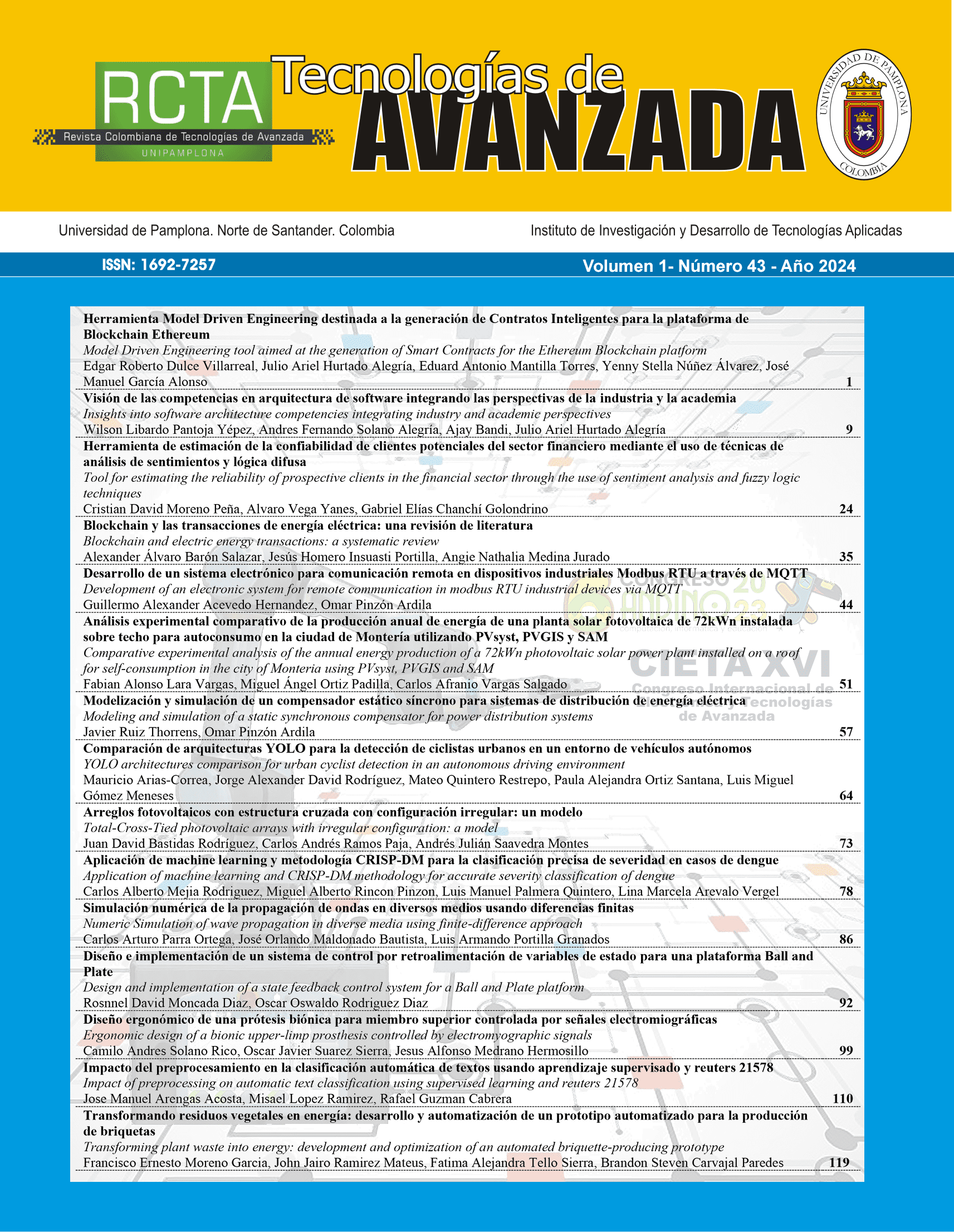Herramienta Model Driven Engineering destinada a la generación de Contratos Inteligentes para la plataforma de Blockchain Ethereum
DOI:
https://doi.org/10.24054/rcta.v1i43.2778Palabras clave:
Blockchain, Contrato Inteligente, Ethereum, MDE, SolidityResumen
La tecnología Blockchain está creciendo a un ritmo acelerado en diferentes entornos. Los contratos inteligentes (SC) son programas descentralizados inmutables para plataformas Blockchain que hacen cumplir, monitorear y ejecutar acuerdos, sin la intervención de un tercero de confianza. Pero, debido a sus especificidades, su desarrollo es un proceso complicado, ya que existen restricciones arquitectónicas de cada plataforma, que los desarrolladores deben comprender. En este trabajo, presentamos una herramienta Model Driven Engineering destinada a la generación de SC para la plataforma de Blockchain Ethereum, para el lenguaje de programación Solidity. Esta herramienta está compuesta de un Metamodelo Especifico de la Plataforma y una Transformación de Modelo a Texto, que permiten generar el código fuente de los SC. También, presentamos una prueba de concepto donde generamos e implementamos un metamodelo, un modelo y desplegamos SC en un entorno sanitario. Los resultados son satisfactorios en cuanto a la sintaxis de los SC generados.
Descargas
Referencias
B. Aldughayfiq and S. Sampalli, “Digital Health in Physicians’ and Pharmacists’ Office: A Comparative Study of e-Prescription Systems’ Architecture and Digital Security in Eight Countries,” OMICS, vol. 25, no. 2, pp. 102–122, 2021, doi: 10.1089/omi.2020.0085.
S. Nakamoto, “Bitcoin: A peer-to-peer electronic cash system,” Decentralized Business Review, p. 21260, 2008.
W. Zou et al., “Smart contract development: Challenges and opportunities,” ITSE, vol. 47, no. 10, pp. 2084–2106, 2019.
P. Wackerow, “Documentación De Desarrollo De Ethereum,” Aug. 2022.
G. A. Oliva, et al., “An exploratory study of smart contracts in the Ethereum blockchain platform,” ESE, vol. 25, no. 3, pp. 1864–1904, 2020, doi: 10.1007/s10664-019-09796-5.
E. R. D. Villarreal, et al., “Blockchain for Healthcare Management Systems: A Survey on Interoperability and Security,” IEEE Access, vol. 11, pp. 5629–5652, Jan. 2023, doi: 10.1109/ACCESS.2023.3236505.
M. Hamdaqa, et al., “IcontractML: A domain-specific language for modeling and deploying smart contracts onto multiple blockchain platforms,”, SAM 2020, 2020, pp. 34–44. doi: 10.1145/3419804.3421454.
I. Qasse, et al., “IContractBot: A Chatbot for Smart Contracts’ Specification and Code Generation,”, BotSE 2021, 2021, pp. 35–38. doi: 10.1109/BotSE52550.2021.00015.
D. Macrinici, et al., “Smart contract applications within blockchain technology: A systematic mapping study,” TIS, vol. 35, no. 8, pp. 2337–2354, 2018, doi: 10.1016/j.tele.2018.10.004.
H. Jin, X, et al. “Towards a novel architecture for enabling interoperability amongst multiple blockchains,”, ICDCS, 2018, pp. 1203–1211.
W. Nam and H. Kil, “Formal Verification of Blockchain Smart Contracts via ATL Model Checking,” IEEE Access, vol. PP, p. 1, Aug. 2022, doi: 10.1109/ACCESS.2022.3143145.
M. Brambilla, et al., Model-Driven Software Engineering in Practice: 2E, Milán, 2017.
J. García, et al., “Desarrollo de Software Dirigido por Modelos Conceptos, Métodos y Herramientas”, Madrid, 2013.
F. Budinsky, Eclipse modeling framework: a developer’s guide. AWP, 2004.
N. Sanchez, et al., (05, 2022) Blockchain smart contract meta-modeling. Disponible: https://digital.cic.gba.gob.ar/handle/11746/11403.
M. Hamdaqa, et al., “iContractML 2.0: A domain-specific language for modeling and deploying smart contracts onto multiple blockchain platforms,” IST, vol. 144, p. 106762, Apr. 2022, doi: 10.1016/J.INFSOF.2021.106762.
G. C. Velasco, et al., “Evaluation of a High-Level Metamodel for Developing Smart Contracts on the Ethereum Virtual Machine,” in AWB, 2023, pp. 29–42.
Descargas
Archivos adicionales
Publicado
Número
Sección
Licencia
Derechos de autor 2024 Edgar Roberto Dulce Villarreal, Julio Ariel Hurtado Alegría, Eduard Antonio Mantilla Torres, Yenny Stella Núñez Álvarez, José Manuel García Alonso

Esta obra está bajo una licencia internacional Creative Commons Atribución-NoComercial 4.0.











